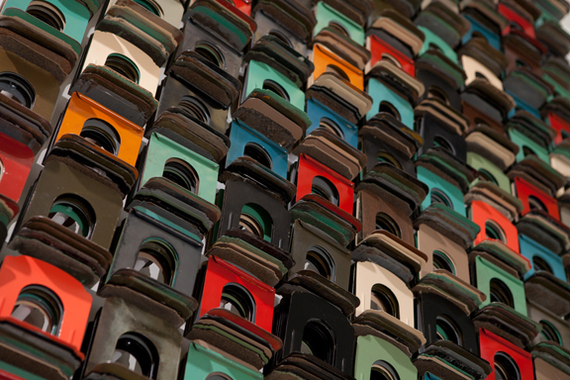Click here to watch the TEDTalk that inspired this post.
If there is a boundary, trust an artist to cross it--and then make you appreciate why.
In Alexa Meade's recent TEDTalk, she discusses how her innovative artwork transforms painting through a cross-pollination of photography, painting and performance. As a fellow interdisciplinary artist, I share Meade's passion for the artistic process and unusual methods of creating artwork to spark conversations about the human condition.
Meade's talk underscores how much material choice matters. An example I would offer is the difference between leather and pleather. They conjure very different responses to the touch, whether you are considering a new handbag or a piece of conceptual art. What something is made of is how we know what it means; real, unreal, manufactured, or harvested. You needn't look further than your local Starbucks to see the power of material choice and design at work. The sumptuous fabrics, dim lighting, and dark wood draw upon the affective qualities of each surface, triggering a sense of desire and comfort as you approach the register.
As we've all come to understand, going to Starbucks is about more than just coffee; it's an experience.
In this era of cell phone snap-shots and social media, the camera has become the most widespread tool for personal expression. The art students I work with have little concern for mastering a particular area of concentration or being known as a "painter," "sculptor," et cetera. Rather, they are interested in learning how to layer various materials in order to succinctly communicate their ideas. Cell phones in hand, they record their activities as material for new projects and as a way to express themselves.
As an interdisciplinary artist, I use a variety of everyday materials to communicate about cultural trends. Over the past few years, I've woven portraits out of shopping bags and embroidery floss. This spring I finished a portrait of Pope Emeritus Benedict made out of 17,000 non-lubricated condoms entitled Eggs Benedict. During the production of this piece, I made many intentional choices, from selecting a festive color palette, to putting great care into the construction of the portrait. Each choice I made sought to ensure that both the subject matter and the materials were celebrated and, through the virtue of their combination, provoked new questions. It was important to me that this piece opened more doors than it closed by remaining both glorious and irreverent at the same time, if that's possible.
This fall, I completed a piece titled Stacked, a permanent sculptural installation made out of 1,600 vintage bookends in the newly renovated Madison Central Public Library. Stacked explores the bookend as an object to be re-imagined and reinterpreted. The colors and shapes of the bookends span 165 years of shifting fashion and design. Stacked highlights the evolving nature of spaces like libraries. As the bookend becomes more of an artifact in the face of today's demand for digital media, this piece symbolizes new landscapes emerging in public space today...
My current projects continue to explore various ways everyday materials can serve as tools for cultural communication. By next spring I will have completed a series of quilts made out of signage from the four Wisconsin Planned Parenthood clinics closed in 2012 due to funding cuts.
With the proliferation of technology in everyday life, artists today, including Alexa Meade, myself, and numerous others have become deeply engaged in the exploration of interdisciplinary practice as means to examine and discuss the modern human experience. By blending materials, traditions, and technologies, the combined efforts of today's artists are changing the way conversations are started--sparking dialogue with a single glance.
Photo credit for Niki Johnson's images in this article go to Eric Baillies.
Ideas are not set in stone. When exposed to thoughtful people, they morph and adapt into their most potent form. TEDWeekends will highlight some of today's most intriguing ideas and allow them to develop in real time through your voice! Tweet #TEDWeekends to share your perspective or email tedweekends@huffingtonpost.com to learn about future weekend's ideas to contribute as a writer.


